When I first started exploring data science, the field felt both exciting and overwhelming, with so many tools, algorithms, and career paths to consider. And I’m not alone: the Bureau of Labor Statistics projects a 34% growth in data scientist jobs by 2032, while AI-driven roles are expanding rapidly. With innovation accelerating through machine learning, big data, and automation, it’s natural to wonder where to begin. In this guide, we’ll demystify data science and artificial intelligence and help you define the educational path that best aligns with your career goals.
Understanding Data Science and AI
In academic writing, data science refers to the study of extracting insights from data, a field that bridges computer science, statistics, and mathematics. Scholars emphasize its interdisciplinary nature: learning from information, testing hypotheses, and supporting decisions with evidence. While the term sounds research-focused, it underpins many practical careers in technology and analytics.
Underlying Methodologies
At the core, data careers rely on three main methodologies: statistics, computing, and research design. Statistics provides ways to measure and test information. Computing, including programming and algorithms, makes it possible to handle large amounts of data quickly. Research design ensures that questions are framed clearly and that answers are valid. Within this, different data science roles emphasize different methods. For example, Data Engineers focus on building reliable systems for storing and moving data while Data Analysts use descriptive statistics and visualization to explain patterns.
Skills Needed for Success
- Data Analysis & Visualization: Using Python libraries like Numpy, Pandas, Seaborn, and Matplotlib to explore and present data.
- Statistics & Probability: Understanding key concepts in descriptive statistics, such as the mean and correlation coefficient, and applying statistical inference, including confidence intervals and hypothesis tests, to draw conclusions about the data.
- SQL & Data Engineering: Querying and organizing data from relational databases and large-scale storage systems.
- Regression & Predictive Modeling: Building and testing models to explain or predict outcomes from existing data.
Data Science and AI in the Workplace
In the workplace, data science translates into a range of careers focused on turning raw information into actionable insight. Common roles include Data Engineer, Data Analyst, Data Scientist, Machine Learning Engineer, and AI Solutions Engineer — each helping organizations use data to solve problems and guide decisions. Here are some Data Science job roles and where they’re focused:
- A Data Engineer builds the pipelines and systems that move and store data so others can use it.
- A Data Analyst explores reports, charts, and dashboards to describe trends and answer questions.
- A Data Scientist applies math, statistics, and coding to build models that explain or predict outcomes.
- A Machine Learning Engineer takes those models and makes them faster, scalable, and ready for real-world use.
- An AI Solutions Engineer blends machine learning with software engineering to design tools and products that apply artificial intelligence directly to business needs.
These roles are connected, but each one emphasizes a different part of the process.
Technical Skills Needed for Data Science and AI Roles
Employers consistently seek a mix of programming skills (Python, R, SQL), data management (databases, cloud platforms like AWS and Google Cloud, and data warehouses such as Redshift or BigQuery), and machine learning frameworks (Scikit-learn, TensorFlow, PyTorch). Tools for data visualization, including Tableau and Power BI, help professionals communicate insights effectively. Soft skills such as problem solving, communication, and teamwork remain equally important because every role must connect technical results to real business decisions.
When looking at data disciplines, the academic perspective and the career perspective overlap, but are not the same. Academic programs stress the theory and foundation behind working with data. They focus on research, math, and scientific thinking. This helps learners understand why methods work and how to test ideas carefully.
The career perspective, however, places more weight on tools and practical skills used every day on the job. Job descriptions highlight programming languages, cloud systems, and visualization software. While the theory is still important, hiring managers often look first for hands-on skills that can be applied to projects right away.
For example, an academic focus might be learning the math behind a regression model. A career focus might be building that model in Python and deploying it with scikit-learn. A Data Engineer may study database theory in school but later use SQL and cloud services like AWS Redshift to handle live data. Both perspectives connect, but the balance shifts from “why it works” to “how it works in practice.”
Academic and Career Perspectives Differences and Overlap
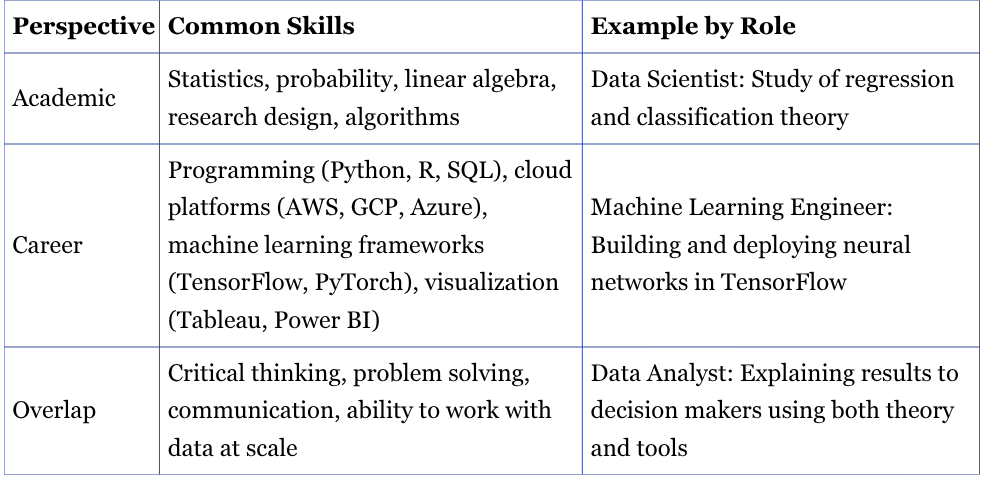
How Artificial Intelligence (AI) Fits Within Data Science
Data Science (DS) is the broader discipline focused on working with data to generate understanding and insight. It involves collecting, cleaning, exploring, and modeling data to uncover patterns, explain outcomes, and support decision-making. Data Science primarily answers questions like “What happened?”, “Why did it happen?”, and “What is likely to happen next?” using statistics, programming, and data visualization.
Artificial Intelligence (AI) is a specialized area within Data Science that focuses on using data to build systems that can learn from experience and make decisions with minimal human intervention. AI relies on data science processes—such as data preparation, feature engineering, and model evaluation—but goes a step further by emphasizing automation and action. AI is commonly used to answer “How can a system learn from data?” and “How can we automate decisions or predictions?”
Artificial Intelligence (AI) is a specialized area within Data Science that focuses on using data to build systems that can learn from experience and make decisions with minimal human intervention. AI relies on data science processes—such as data preparation, feature engineering, and model evaluation—but goes a step further by emphasizing automation and action. AI is commonly used to answer “How can a system learn from data?” and “How can we automate decisions or predictions?”
In practice, data science provides the foundation, while AI represents an advanced application of data science techniques. A data scientist may explore and explain trends in customer behavior, while an AI system built on that work might automatically recommend products, detect fraud, or generate text or images. In short, AI is not separate from data science—it builds on it, turning data-driven insights into intelligent, automated systems that operate at scale.
Key Skills in AI
- Machine Learning (ML): Training models to make predictions or decisions without explicit programming.
- Natural Language Processing (NLP): Teaching machines to understand and generate human language.
- Neural Networks (NN): Using deep learning techniques to process complex data like images, text, and time series.
- Big Data Tools: Leveraging PySpark and other tools to handle massive datasets.
Career Paths in AI
- AI Engineer: Develops and deploys AI models and systems.
- Machine Learning Engineer: Focuses on building and optimizing machine learning algorithms.
- AI Researcher: Explores new AI techniques and applications.
Shared Frameworks and Methods in Data Science and AI
Data science and AI use well-known frameworks and methodologies to guide how problems are solved. These approaches help professionals move from raw data to clear results. Below are some of the most common standards recognized across industries.
The Cross-Industry Standard Process for Data Mining (CRISP-DM) is one of the most widely used frameworks. It outlines clear project stages: business understanding, data preparation, modeling, evaluation, and deployment. This process is common in corporate and government settings because it is flexible and can be used across industries.
Machine Learning (ML) is a set of methods that allow computers to learn patterns from data. Instead of writing rules by hand, practitioners build models that improve as more data is added. Banks use it for fraud detection, and hospitals use it for predicting patient outcomes.
Neural Networks (NN) are machine learning models inspired by the way the human brain processes information. They excel at recognizing images, speech, and complex patterns. For example, real estate companies use neural networks to estimate housing prices from property photos and location data.
Deep Learning (DL) is a specialized form of neural networks with multiple processing layers. It is used in industries like medical imaging, where detail matters. Hospitals apply deep learning to detect signs of disease in X-rays and MRI scans.
Large Language Models (LLMs), such as GPT, are advanced AI models trained on vast amounts of text. They can generate human-like responses, summarizing documents, and translating languages. Government agencies and corporations are exploring the use for drafting reports and analyzing large volumes of text data.
Generative AI (Gen AI) builds on deep learning and LLMs to create new content, including text, images, and even music. Retailers use it to produce product descriptions automatically, while nonprofits generate multilingual training materials quickly and cost-effectively.
Frameworks and Methods in Practice
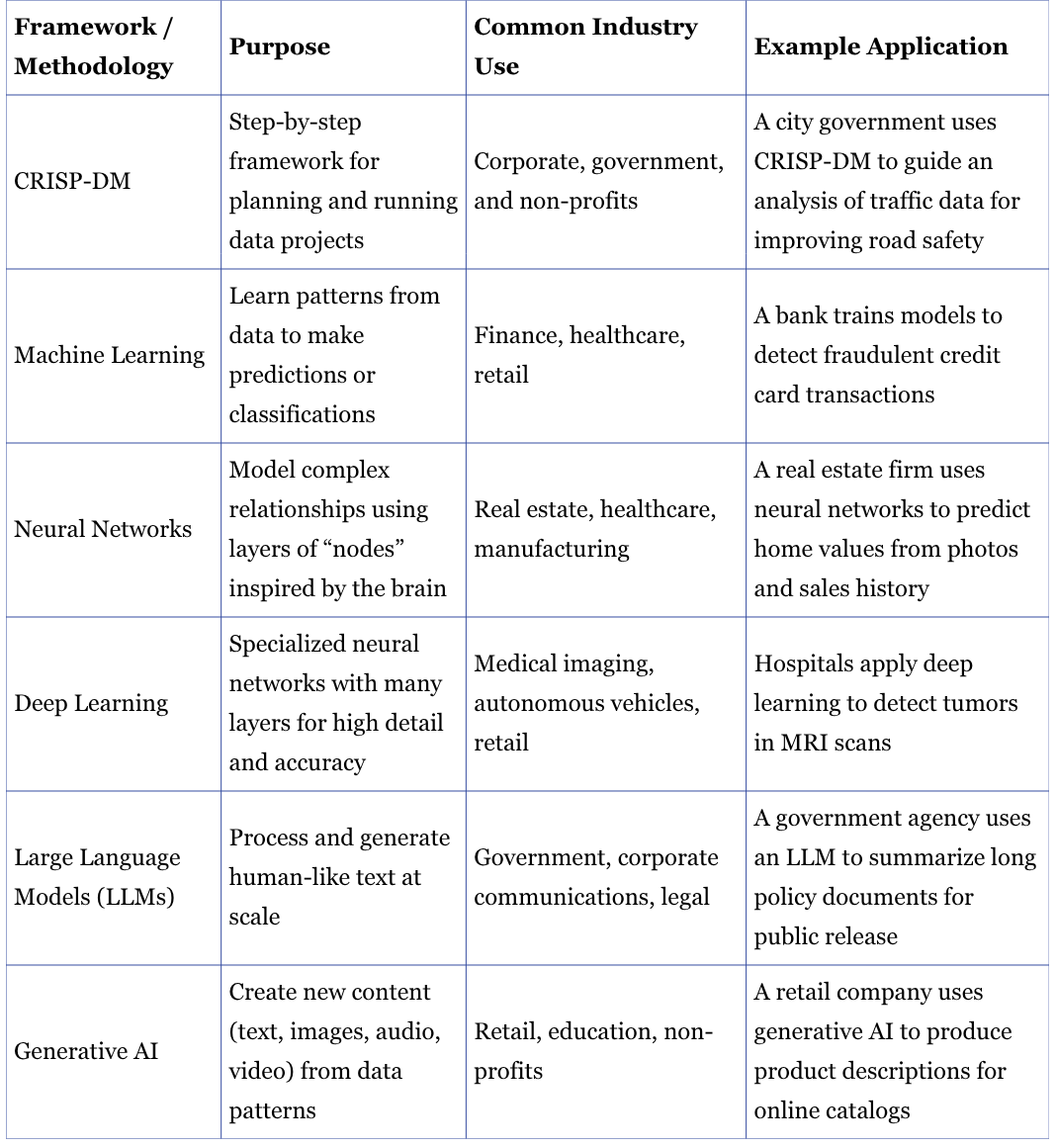
These approaches all fit within data science and AI but serve different roles. CRISP-DM provides a structured project roadmap, while the others focus on building or training models that learn, predict, or create. Some emphasize process; others emphasize intelligent automation.
Similarities and Differences Between Frameworks and Methods
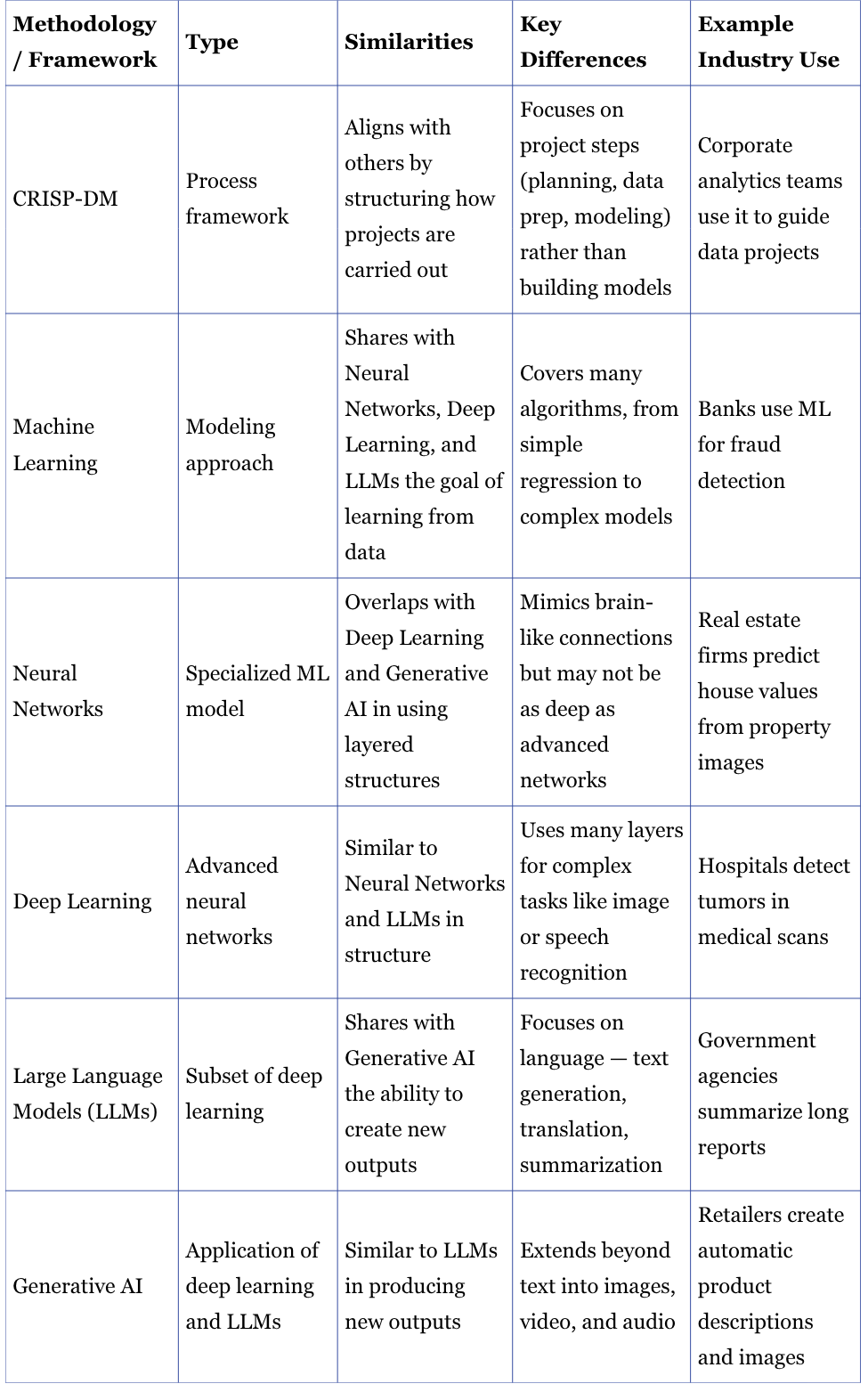
Prerequisites and Readiness
AI and Data Science
Before starting an AI and data science program, it’s helpful to refresh key skills to ensure a smooth transition into the coursework.
Mathematics and Statistics: A solid grasp of high school math is important. Review algebra, functions, and graphing, and revisit probability and descriptive statistics since these foundations lead directly into inferential statistics and machine learning later in the program.
Technology and Computing: Basic computer literacy is expected — navigating files, installing programs, and using spreadsheets. Because the curriculum starts with Python (Course 1), exposure to logical thinking or simple coding (like Excel formulas) can be especially helpful.
Data Awareness: Comfort with reading charts, graphs, and reports is valuable. This skill supports early work in exploratory data analysis (EDA), SQL querying, and data visualization.
Content Topics Best to Refresh
- Algebra and basic linear equations (foundation for statistics and ML)
- Probability concepts such as likelihood and random events
- Descriptive statistics: mean, median, standard deviation
- Spreadsheet basics (Excel or Google Sheets)
- Introductory programming logic (variables, loops, functions)
AI and Data Science Prerequisite Knowledge
.png)
For more details, check out our curriculum:
If you still have questions, please reach out to our admissions team for more information.
Frequently Asked Questions
Will Data Science be replaced by AI?
No, data science and AI work together to solve different problems.
Data science lays the groundwork by cleaning, organizing, and modeling data. Data Science answers questions like "what happened?" and "why did it happen?”
AI builds on that foundation to create systems that automate tasks, generate new content, and support smarter decisions. AI answers questions like “What will happen?” and “How can we make it happen automatically?”
How does Data Science enhance AI, and vice versa?
Data science and AI work hand in hand to enhance capabilities. Data science fuels AI by preparing and organizing raw, unstructured data for machine learning algorithms and AI models, a critical step in effective data management. Data scientists also monitor AI performance through statistical analysis to evaluate accuracy, identify bias, and continuously optimize AI-powered systems. In turn, AI boosts data science by automating labor-intensive tasks (data cleaning, web scraping, and predictive modeling) while also enabling advanced predictive analytics for complex problems (generative AI for image creation or machine learning algorithms for decision-making across various industries).
What is one example of how Data Science and AI are used in everyday industries?
Data science and AI are used every day across many industries. Combining methods like statistics, machine learning, and research design with skills such as programming, database management, and data visualization. These tools help organizations turn information into clear actions. For example, banks and insurance companies rely on AI to detect fraud and manage risk. Machine Learning Engineers create models that scan thousands of transactions per second for unusual patterns. Data Engineers ensure these massive streams of information are processed efficiently using cloud platforms like AWS. Data Scientists refine the models with techniques such as logistic regression. Data analysts explain fraud trends to business leaders.
Why is strong Data Science foundation essential for AI?
AI is a subset of Data Science, meaning that many of the skills and techniques used in AI are built on core Data Science concepts. To excel in AI, it’s essential to have a strong foundation in Data Science, as this provides the tools and knowledge necessary to develop, train, and evaluate AI models effectively. For example, AI models require clean, structured data, which is a core skill of Data Science. Many AI techniques, such as regression and classification, are rooted in statistics. Both fields rely on programming skills in Python, SQL, and tools like pandas and PySpark. Additionally, Data Science introduces machine learning concepts, which are further expanded and applied within AI.
Why are these frameworks and methodologies included in the curriculum?
Each of the frameworks and methods (see charts above) was chosen because it reflects both academic foundations and what employers ask for in real jobs. Together, giving learners a strong balance between theory and practice.
CRISP-DM is included because it teaches students how to think through an entire project from start to finish. It is an industry standard that helps bring order to complex work.
Machine Learning is included because it is the base of many modern data science tasks. Knowing how models learn from data is important across almost every sector, from healthcare to finance.
Neural Networks and Deep Learning are included because these are the engines behind computer vision, speech recognition, and other advanced applications. These skills are in high demand and prepare students for technical roles.
Large Language Models and Generative AI are included because this represents the newest wave of tools shaping workplaces. Learning them prepares students to use cutting-edge AI responsibly and creatively in areas like business, education, and public service.
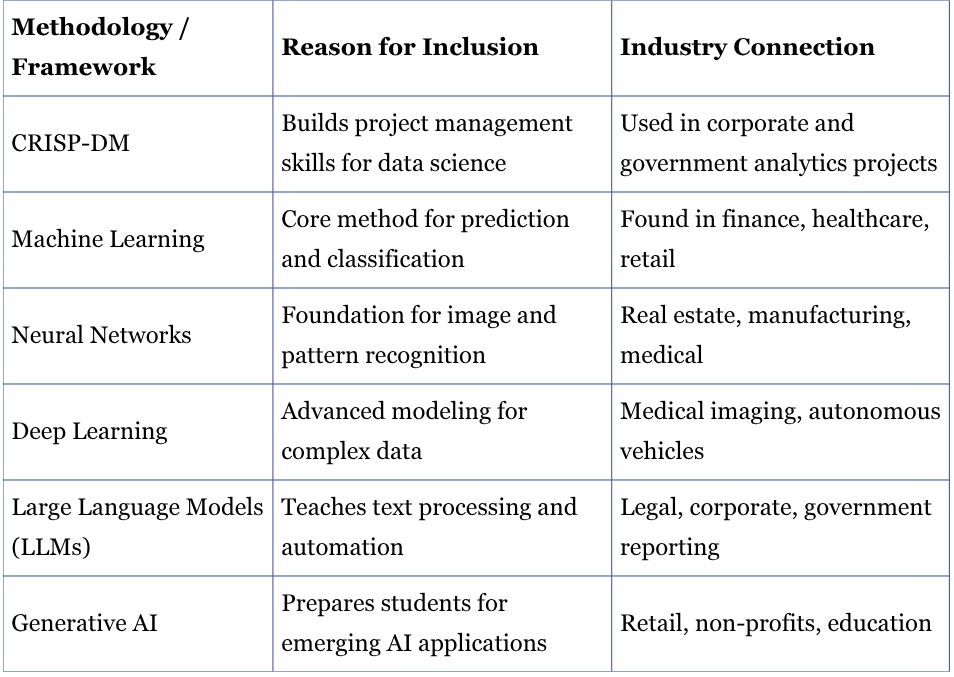

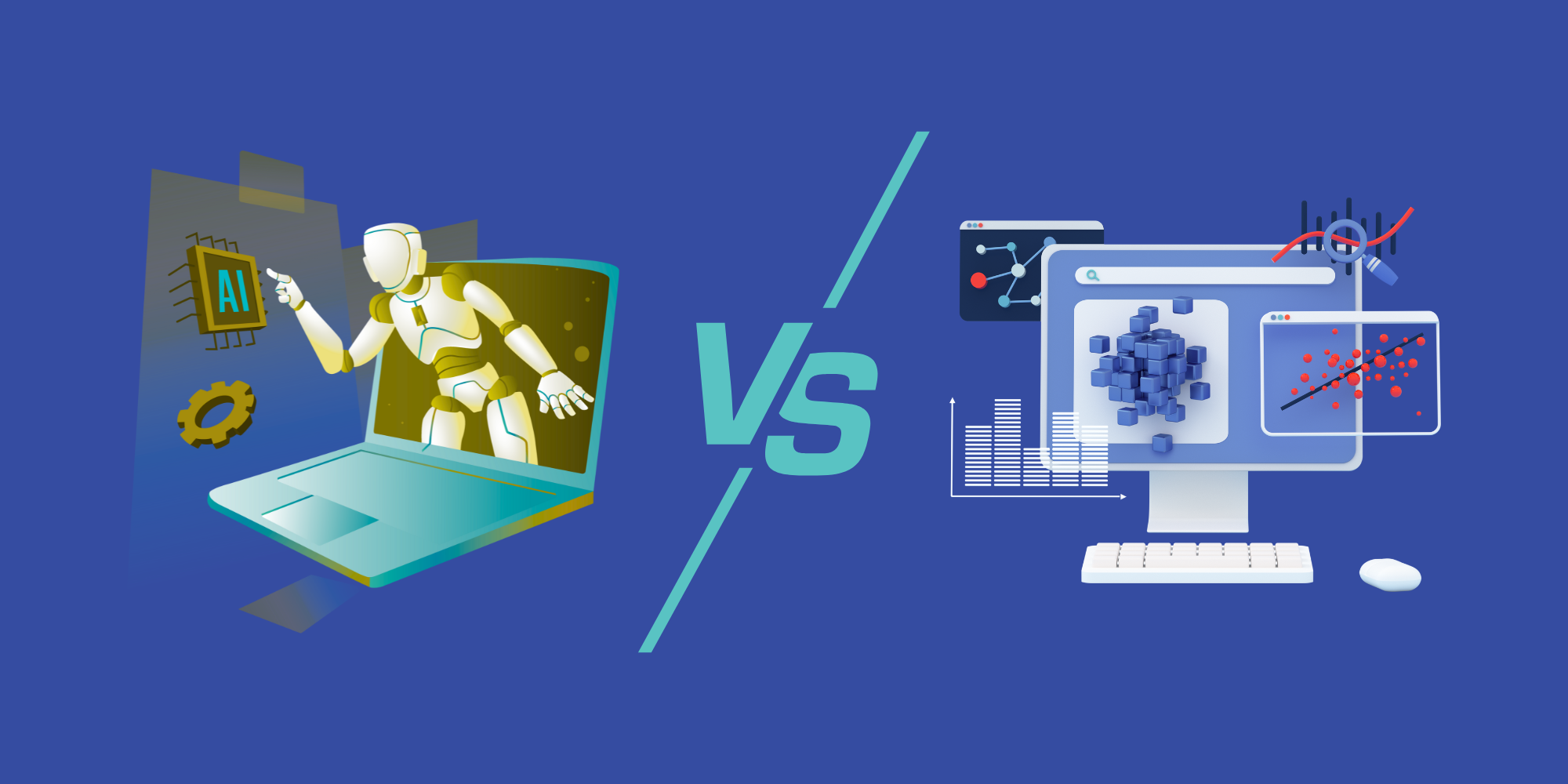


.png)
.png)
.png)
